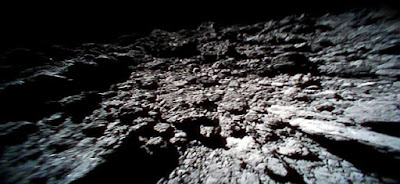Asteroid (162173) Ryugu 1999 JU3 passed by the Earth at a distance of about 9 055 000 km (23.6 times the average distance between the Earth and the Moon, or 6.05% of the distance between the Earth and the Sun), slightly after 0.45 am GMT on Tuesday 29 December 2020. There was no danger of the asteroid hitting us, though were it to do so it would have presented a considerable threat. (162173) Ryugu 1999 JU3 has an estimated equivalent diameter of 850-880 m (i.e. it is estimated that a spherical object with the same volume would be 850-880 m in diameter), and an object of this size would be predicted to be capable of passing through the Earth's atmosphere relatively intact, impacting the ground directly with an explosion that would be about 120 million times as powerful as the Hiroshima bomb. Such an impact would result in an impact crater over 10 km in diameter and devastation on a global scale, as well as climatic effects that would last decades or even centuries.
(162173) Ryugu 1999 JU3 was discovered on 10 May 1999 by the Massachusetts Institute of Technology's Lincoln Near Earth Asteroid Research Laboratory in Socorro, New Mexico. The designation 1999 JU3 implies that it was the 95th asteroid (asteroid U3 - in numbering asteroids the letters A-Y, excluding I, are assigned numbers from 1 to 25, with a number added to the end each time the alphabet is ended, so that A = 1, A1 = 26, A2 = 51, etc., which means that U3 = (25 X 3) + 20 = 95) discovered in the first half of May 1999 (period 1999 J - the year being split into 24 half-months represented by the letters A-Y, with I being excluded), while the designation 162173 implies that it was 162 173th asteroid ever discovered (asteroids are not given this longer designation immediately to avoid naming double or false sightings). The name 'Ryugu' was given to the asteroid by the Minor Planet Center on 28 September 2015; it is a reference to Ryūgū-jō, the underwater palace of the Dragon Ryūjin. In Japanese folklore this palace was visited by the fisherman Urashima Tarō, who returned with a gift of a magical box. The name was chosen to reflect the visit to the asteroid made by the Japanese space probe Hayabusa2, and the box of samples it returned with.
(162173) Ryugu 1999 JU3 has a 474 day (1.30 year) orbital period, with an elliptical orbit tilted at an angle of 5.88° to the plain of the Solar System which takes in to 0.96 AU from the Sun (96% of the distance at which the Earth orbits the Sun) and out to 1.42 AU (142% of the distance at which the Earth orbits the sun). It is therefore classed as an Apollo Group Asteroid (an asteroid that is on average further from the Sun than the Earth, but which does get closer). As an asteroid probably larger than 150 m in diameter that occasionally comes within 0.05 AU of the Earth, (162173) Ryugu 1999 JU3 is also classified as a Potentially Hazardous Asteroid. This means that (162173) Ryugu 1999 JU3 has occasional close encounters with the Earth, with the last thought to have happened in July 2016 and the next predicted in June 2015. The asteroid also has occasional close encounters with the planet Mars, which it last cam close to in April last year (2020) and is next predicted to pass in January 2071.
The Hayabusa2 spacecraft was launched by the Japan Aerospace Exploration Agency in December 2014 and reached (162173) Ryugu 1999 JU3 on 27 June 2018. The spacecraft deployed four 'rovers' to the surface of the asteroid, which where cylidrical in shape, and able to 'hop' about by the movement of mass within the casing. These probes explored the surface of the asteroid, helping with the identification of a landing site for Hayabusa2 itself. The spacecraft landed on (162173) Ryugu 1999 JU3 on 21 February 2019, where it collected samples from the surface of the asteroid. A second set of samples were later collected by firing a metal bullet at the asteroid from orbit and collecting some of the ejecta. These samples were successfully returned to Earth on 5 December 2020.
See also...



Follow Sciency Thoughts on Facebook.
Follow Sciency Thoughts on Twitter.






